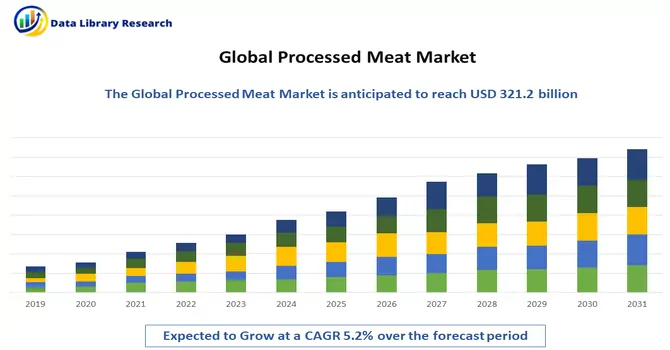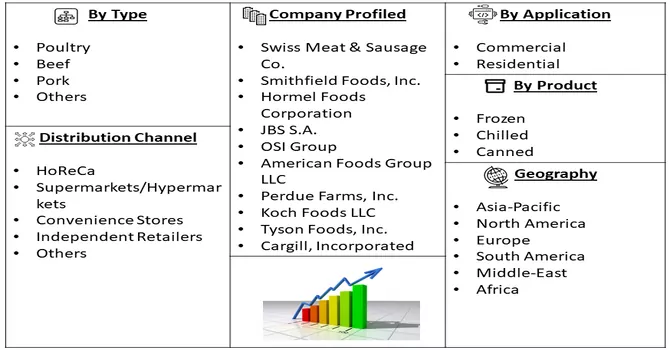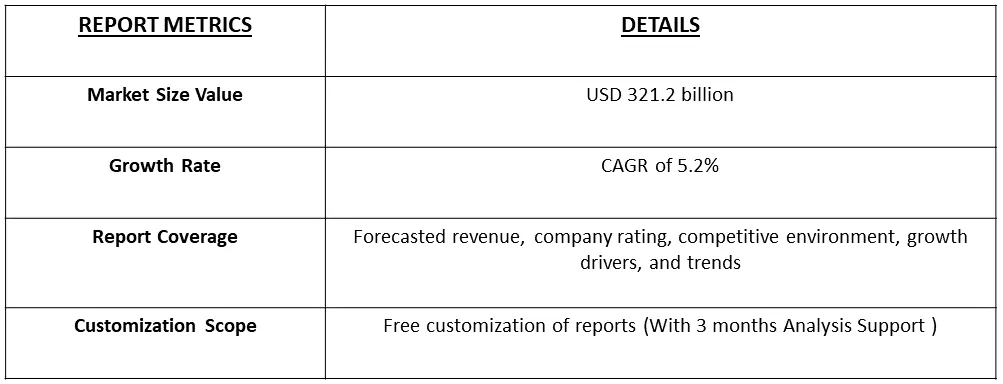The global processed meat market size was valued at USD 321.2 billion in 2022 and is expected to register a CAGR of 5.2% from 2023 to 2030.

Get Complete Analysis Of The Report - Download Free Sample PDF
Processed meat refers to meat products that have undergone various methods of preservation, cooking, or transformation to enhance flavour, improve shelf life, or modify the texture of the meat. These processes often involve adding ingredients such as salt, curing agents, seasonings, preservatives, or other additives to modify the taste and appearance of the meat. Common examples of processed meats include sausages, hot dogs, bacon, ham, salami, and deli meats. The processing methods may include curing, smoking, fermenting, or cooking the meat. While these processes can enhance the flavour and characteristics of the meat, it's important to note that some processed meats may contain added sodium, nitrates, or other preservatives.
The increasing urbanization has led to shifts in dietary patterns. Urban dwellers often seek convenient and quick meal options, making processed meats a favourable choice. Additionally, globalized diets and culinary influences contribute to the popularity of processed meat products. The expansion of retail outlets, supermarkets, and convenience stores provides increased accessibility to processed meat products. A well-established distribution network ensures that these products are readily available to a broader consumer base.
Market Segmentation: Processed Meat Market is Segmented by Meat Type (Poultry, Beef, Pork, and Others), Product Type (Frozen, Chilled, and Canned), Application (Commercial and Residential), and Distribution Channel (HoReCa, Supermarkets/Hypermarkets, Convenience Stores, Independent Retailers, and Others) and Geography (North America, Europe, Asia-Pacific, Middle-East and Africa, and South America). The value is provided in terms of (USD million) for the above segments.

For Detailed Market Segmentation - Download Free Sample PDF
The demand for healthier processed meat options is driving innovation in product formulations. Low-fat, low-sodium, and nitrate-free processed meat products are gaining traction as consumers become more health-conscious and seek nutritious alternatives. Moreover, the trend towards snacking and on-the-go consumption is influencing the development of convenient processed meat snacks. Single-serve packages, portable formats, and portion-controlled options cater to consumers' busy lifestyles and desire for quick, portable protein sources.
Market Drivers:
Rapid Urbanization and Migration to Urban Areas and Technological Advancements Facilitate Transportation
The global phenomenon of rapid urbanization has led to a substantial increase in the population residing in urban areas. Urban lifestyles are characterized by fast-paced routines, demanding convenient and time-efficient food solutions. This shift has propelled the demand for processed meat products that offer quick and convenient meal options. The rise of e-commerce and online grocery platforms has further facilitated the accessibility of processed meat products in urban areas. Consumers can conveniently order a variety of processed meats online, and efficient last-mile delivery services ensure that these products reach urban households promptly.
Moreover, technological advancements in meat processing plants, including automation and robotics, enhance efficiency, reduce processing times, and improve product consistency. This not only benefits manufacturers but also contributes to meeting the growing demand for processed meat products in urban markets.
Growing Penetration of Retail Chains in Emerging Markets
The synergy between retail chains and e-commerce platforms further enhances accessibility. Consumers in emerging markets can explore and purchase processed cheese products online, complementing their in-store experiences and contributing to the overall market growth. The association with established retail chains often necessitates adherence to rigorous quality standards and regulatory compliance. This emphasis on quality assurance benefits consumers, assuring them of the safety and standards maintained by processed cheese products available in these retail outlets. Thus, the integration of processed cheese products into the retail ecosystems of emerging markets reflects a dynamic interplay between changing consumer dynamics, urbanization, and the strategic initiatives of retail chains. This trend not only opens up new avenues for market expansion but also presents exciting opportunities for collaboration and innovation within the processed cheese industry.
Market Restraints :
Health Concerns and Nutrition Perception and Rising Demand for Natural and Artisanal Cheese
The increased awareness of health issues and a growing focus on nutrition have led consumers to scrutinize their dietary choices. Processed cheese products are often criticized for their high levels of sodium, saturated fats, and additives, contributing to concerns about their nutritional value. Health-conscious consumers may opt for alternatives perceived as healthier, impacting the processed cheese market. Moreover, there is a discernible shift in consumer preferences toward natural and artisanal cheeses, driven by a desire for authentic, high-quality, and minimally processed products. The artisanal cheese segment competes with processed cheese as consumers seek more genuine and less processed options. Thus, owing to such reasons, the market is expected to slow down the growth of the studied market over the forecast period.
Segmental Analysis :
The Poultry Segment is Expected to Witness Significant Growth Over the Forecast Period
The poultry industry is a crucial component of the global food supply chain, encompassing the breeding, farming, and processing of chickens, turkeys, ducks, and other avian species. Poultry products, including fresh and processed meat, eggs, and by-products, are staples in diets worldwide. Poultry farming involves the controlled breeding and raising of domesticated birds for meat and egg production. Farms may vary in scale, from small backyard operations to large commercial enterprises. Common poultry breeds include broilers for meat and layers for egg production. Moreover, the processed meat industry involves the transformation of raw meat into a variety of value-added products through methods such as curing, smoking, fermentation, and packaging. Processed meat products include sausages, bacon, ham, hot dogs, and various convenience items like pre-cooked chicken strips. Thus, owing to such benefits the market is expected to benefit, and the segment is expected to witness significant growth over the forecast period.
Frozen Segment is Expected to Witness Significant Growth Over the Forecast Period
Frozen processed meat has become a staple in modern kitchens, offering consumers a convenient and versatile solution for quick and easy meal preparation. This category of processed meat combines the benefits of preservation and convenience, making it a popular choice for households and the food service industry. The production of frozen processed meat involves various processing techniques to enhance flavour, texture, and shelf life. Common methods include curing, smoking, marinating, and seasoning before freezing. Rapid freezing techniques are employed to preserve the meat's quality by minimizing the formation of ice crystals, ensuring a better texture upon thawing. Thus, frozen processed meat has become a valuable and convenient culinary solution, offering consumers a wide array of options that balance convenience, quality, and versatility.
Commercial Segment is Expected to Witness Significant Growth Over the Forecast Period
The commercial application of processed meat has witnessed significant growth, transforming the food industry and consumer preferences. Processed meat products, created through various techniques and flavour profiles, play a vital role in meeting the demand for convenient, ready-to-eat, and diverse culinary options. Processed meat plays a crucial role in mass catering for events, conferences, and large gatherings. Its versatility allows for the preparation of diverse dishes that can accommodate varying dietary preferences. Sausages, cold cuts, and pre-cooked meats simplify the logistics of serving large groups. Thus, owing to such benefits, the segment is expected to witness significant growth over the forecast period.
Supermarkets/Hypermarkets Segment is Expected to Witness Significant Growth Over the Forecast Period
Supermarkets and hypermarkets play a pivotal role in the distribution and consumption of processed meat products, fostering a symbiotic relationship that caters to the demands of modern consumers seeking convenience, variety, and quality in their food choices. The convenience factor is a driving force in the popularity of processed meat in supermarkets and hypermarkets. Consumers can easily access processed meat products during their routine grocery shopping, eliminating the need for separate trips to speciality stores or butchers. Thus, supermarkets and hypermarkets serve as central hubs for the distribution, promotion, and consumption of processed meat products. Their role in providing convenience, diverse choices, and a platform for innovation underscores the significant impact these retail establishments have on shaping consumer preferences and the overall processed meat market.
North America Segment is Expected to Witness Significant Growth Over the Forecast Period
North America boasts a diverse and robust market for processed meat, reflecting a wide array of consumer preferences, culinary traditions, and lifestyle choices. Processed meat products have become an integral part of the region's food culture, offering convenience and versatility. A variety of processed meat products are popular in North America, including bacon, sausages, hot dogs, deli meats, pre-marinated cuts, and frozen processed meat items. These products cater to the region's dynamic culinary landscape and the demand for quick and convenient meal solutions.
Moreover, North America embraces regional and artisanal varieties of processed meat products, contributing to a rich tapestry of flavours. Artisanal bacon, speciality sausages, and unique deli meats reflect the diverse culinary influences and preferences across different states and provinces. Thus, the region is expected to witness significant growth over the forecast period.

Get Complete Analysis Of The Report - Download Free Sample PDF
Key players are forming strategic partnerships with other industry leaders, collaborators, or research institutions. These partnerships enable them to leverage complementary strengths, share resources, and collectively explore new opportunities in the market. Moreover, integrating cutting-edge technologies into production processes is a pivotal strategy for staying competitive. By adopting technological advancements, key players aim to enhance the efficiency of their operations, improve product quality, and meet the evolving demands of the market. Some of the key market players are:
Recent Development:
1) In August 2022, Tyson Foods revealed its plans for the expansion of the Caseyville Prepared Foods Facility, marking a substantial investment of USD 180 million. This strategic initiative is geared towards meeting the escalating demand for Tyson Foods' renowned Hillshire Farm® and Jimmy Dean® branded products. Anticipated to commence production in the upcoming fall, the first line of the expansion project aims for completion by the summer of 2023. Currently specializing in the production of Hillshire Farm® and Jimmy Dean® items, the Caseyville plant's 170,000 square foot expansion is expressly designed to accommodate an increased production capacity for grab-and-go snacking as well as breakfast items.
2) In July 2022, BRF Sadia celebrated the inauguration of its new plant, named 'Al Joody,' located in Dammam, Saudi Arabia. This development significantly elevates the company's monthly production capacity to an impressive 1,200 tons of food. Positioned as a pivotal player in fostering the growth and progress of the local poultry industry, the Al Joody plant underscores BRF Sadia's commitment to meeting the evolving needs of the Saudi consumer. This expansion not only contributes to the company's production capabilities but also plays a crucial role in advancing the broader poultry industry landscape in the region.
Q1. What was the Processed Meat Market size in 2022?
As per Data Library Research the global processed meat market size was valued at USD 321.2 billion in 2022.
Q2. What is the Growth Rate of the Processed Meat Market?
Processed Meat Market is expected to register a CAGR of 5.2% over the forecast period.
Q3. What are the factors on which the Processed Meat market research is based on?
By Meat Type, By Product Type, By Application, By Distribution Channel and Geography are the factors on which the Processed Meat market research is based.
Q4. Which Region is expected to hold the highest Market share?
North America region is expected to hold the highest Market share.
Data Library Research are conducted by industry experts who offer insight on industry structure, market segmentations technology assessment and competitive landscape (CL), and penetration, as well as on emerging trends. Their analysis is based on primary interviews (~ 80%) and secondary research (~ 20%) as well as years of professional expertise in their respective industries. Adding to this, by analysing historical trends and current market positions, our analysts predict where the market will be headed for the next five years. Furthermore, the varying trends of segment & categories geographically presented are also studied and the estimated based on the primary & secondary research.
In this particular report from the supply side Data Library Research has conducted primary surveys (interviews) with the key level executives (VP, CEO’s, Marketing Director, Business Development Manager and SOFT) of the companies that active & prominent as well as the midsized organization
FIGURE 1: DLR RESEARH PROCESS

Extensive primary research was conducted to gain a deeper insight of the market and industry performance. The analysis is based on both primary and secondary research as well as years of professional expertise in the respective industries.
In addition to analysing current and historical trends, our analysts predict where the market is headed over the next five years.
It varies by segment for these categories geographically presented in the list of market tables. Speaking about this particular report we have conducted primary surveys (interviews) with the key level executives (VP, CEO’s, Marketing Director, Business Development Manager and many more) of the major players active in the market.
Secondary ResearchSecondary research was mainly used to collect and identify information useful for the extensive, technical, market-oriented, and Friend’s study of the Global Extra Neutral Alcohol. It was also used to obtain key information about major players, market classification and segmentation according to the industry trends, geographical markets, and developments related to the market and technology perspectives. For this study, analysts have gathered information from various credible sources, such as annual reports, sec filings, journals, white papers, SOFT presentations, and company web sites.
Market Size EstimationBoth, top-down and bottom-up approaches were used to estimate and validate the size of the Global market and to estimate the size of various other dependent submarkets in the overall Extra Neutral Alcohol. The key players in the market were identified through secondary research and their market contributions in the respective geographies were determined through primary and secondary research.
Forecast Model
